Every visitor to Hanoi should take the time to wander around the Old Quarters of Hanoi. The Old Quarters is a series of streets at the heart and center of Hanoi.
Hanoi’s Old Quarters has a vibrant and varied history. It has long been the center of commerce in Hanoi and Vietnam. The Old Quarters also uses the name of 36 Streets. Even though there are more than 36 streets in the Old Quarters area, they call it 36 Streets due to the 36 guilds or crafts once sold there. Streets are named for the different products they once sold. One of the best ways to see the Old Quarters is by the Electric Bus or Golf Cart.
Table of Contents
- Video – Exploring Hanoi’s Old Quarters: A Unique Golf Cart Journey
- History of the Hanoi’s Old Quarters
- The 36 Streets of Hanoi’s Old Quarters
- Riding the Electric Golf Cart to see the Old Quarters
- Related Questions
Video – Exploring Hanoi’s Old Quarters: A Unique Golf Cart Journey
Embark on an enchanting ride through the historic heart of Hanoi, Vietnam, aboard a golf cart. This unique tour offers an intimate and leisurely way to navigate the narrow lanes and bustling streets of the Old Quarters. Gliding past ancient architecture and vibrant markets, you’ll experience the rich tapestry of Hanoi’s history and culture.
The gentle pace allows for an immersive experience, providing ample opportunities to observe the daily life and traditions of the local people. Discover hidden gems, from quaint tea shops to artisan workshops, and soak in the lively atmosphere that makes Hanoi’s Old Quarters a must-visit destination.
This golf cart adventure is not just a tour; it’s a journey into the soul of a city steeped in heritage and charm. Come with us on a ride through Hanoi’s Old Quarters on a Golf Cart:
History of the Hanoi’s Old Quarters
The Old Quarters of Hanoi are small streets lined with charming old colonial architecture, pagodas, and temples. The area is near the Hoan Kiem Lake District of Hanoi or downtown Hanoi.
The Old Quarters has a history that dates back to the 10th Century when the Ly Dynasty (1010-1225) was ruling Vietnam, and they moved to the capital of Hanoi. At the time, a community of craftsmen also followed the Emperor to Hanoi to set up the new city. The craftsmen who had the same trade would then form a guild, which could be today equated to a trade association. The reason they formed the guilds was to protect their livelihoods.
By the 11th Century, the Old Quarters started to get a reputation of an area filled with guilds and artisans. In the 11th Century, when Vietnam obtained its independence from China, King Ly Thai built his palace in the area of the present-day Old Quarters. So, this cluster of artisans started to branch out into other parts of the Old Quarters.
Most of the crafts streets would have a temple dedicated to the mythical founder of their craft. The temple’s ground floor was often used for commerce or conducting business, while the other floors or areas were a Temple. Most temples have since been destroyed, but the Ma May and Kim Co Temples have survived.
There used to be several city gates also in the Old Quarters area. Now the only gate that has survived is the Quan Cuong gate.
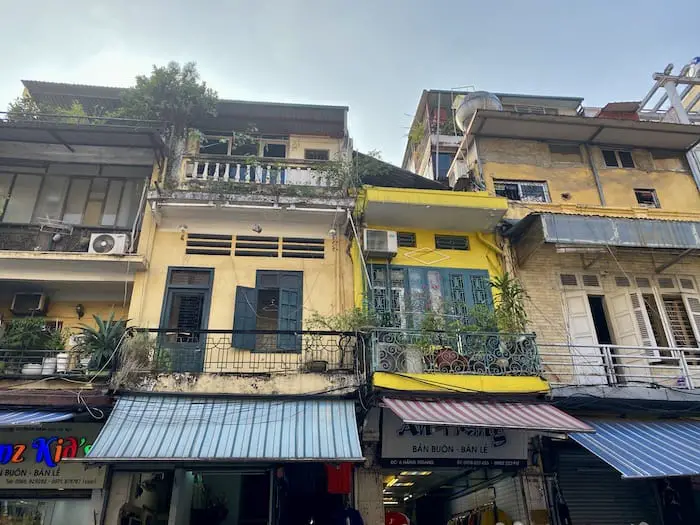
French Rule and Hanoi’s Old Quarters
When the French ruled Vietnam, they partially rebuilt the Old Quarters. Today, most of the buildings are remnants of the French era. To see some of the beautiful French architecture, you may need to look up to see the 2nd or 3rd floors of many of the buildings.
Most first floors have been modernized or changed into shops, restaurants, or hotels. It is usually on the higher floors that show the French historical architectural past.
Most of the historic houses built during the French era are shophouses. A shophouse is a house that is attached to another house. The houses will all share some walls. These shophouses have slanted tiled roofs, and many have old French balconies on the 2nd or 3rd floor.
Most old French shophouses were built in the 18th and 19th centuries. Before this time, the houses would have had a thatched roof.
Looking at many of the buildings in Vietnam and even in present-day Vietnam, most people realize that most buildings are tall and narrow. This is also true in the old quarters.
The front can be narrow, but the building may go back far or deep. This is because of the way the people were taxed under the French. It is part of the tax code that remained for quite a while, even after the French left Vietnam.
Their building’s width calculated the property or home tax, so they would make the front width of the house small to minimize their tax burden. The houses were usually 3 meters wide, and 60 meters long, and these skinny houses were called “tube” houses.
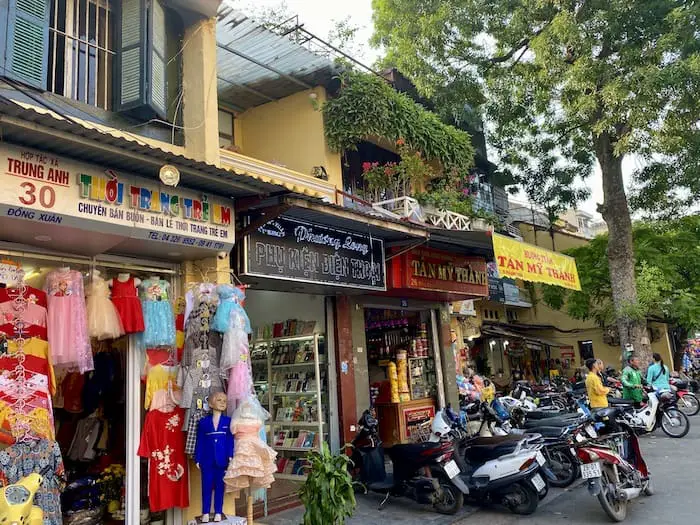
Due to wars, decay, poverty, and other disasters, since the 20th Century, many of these older French shophouses have been dwindling in number. People may have torn them down to make room to build a taller home with more space and room for the entire family.
The Vietnamese government understands this part of their heritage, so they have had restoration projects to preserve the Old Quarters and many older shophouses.
In the French period of Vietnam, many French and Indian settlers moved to the Old Quarters to conduct business and trade in goods and services. Two smaller markets were demolished to make way for the Dong Xuan Market, a still-standing market today. Also, a tramway was constructed throughout the old quarters, but the tramway is no longer operating.
When you go through the Old Quarters’ streets, you can only imagine how the area was Hanoi’s commercial heart; the Old Quarters still play a significant role in Hanoi today.
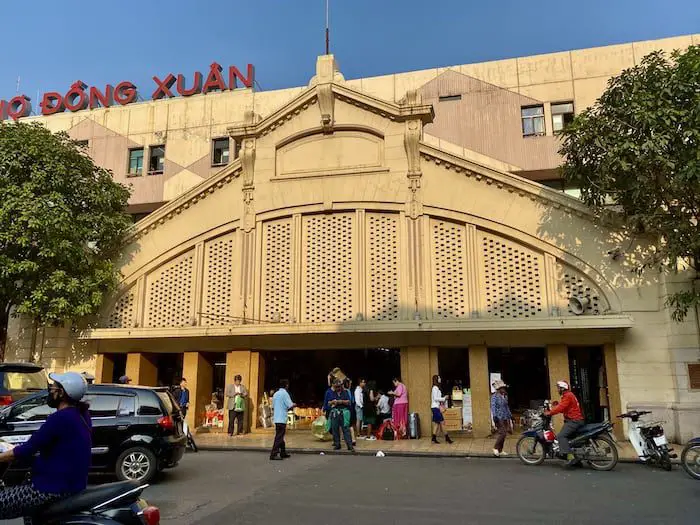
The 36 Streets of Hanoi’s Old Quarters
No one is sure where the name 36 Streets came from when referring to the Old Quarters, as the area has more than 36 Streets. Some historians believe that 36 Streets came from the 15th Century when the area had 36 guilds or crafts sold.
Others feel the name came from Eastern philosophy and teachings. In the East, the number 9 can also mean long-lasting or abundance. The Vietnamese see nine as a lucky number because it is the last number before we start with 10, which is one plus a 0.
If you take nine and multiply it by the four directions (north, south, east, and west), you also come up with the number 36. This, of course, for the ancient traders would have had an essential hidden meaning of luck or prosperity.
Most of the streets in Hanoi’s Old Quarters start with the word Hang, which means merchandise or shop in Vietnamese. So you have Hang Gai Street, Silk Street, Hang Bac Street, and Silver Street.
The street’s names tell of the ancient and even present-day trades and crafts on the streets. The walk along these streets is a walk in history.
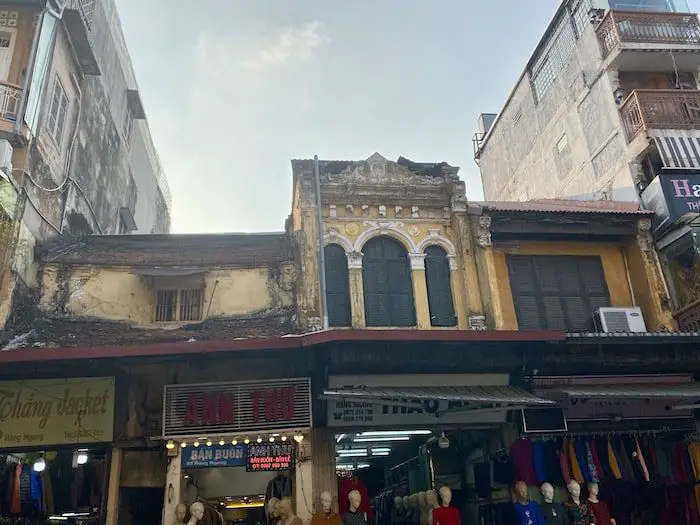
Major Old Quarter Streets and their meanings
There are about 70 streets in the Old Quarters area, but here are some of the most well-known streets:
- Hang Bac Street – The Silver Street – Hang Bac is one of the oldest streets, dating back to the 13th Century. The street was known to manufacture silver during the time of King Le Thanh Tong. Since the 18th century, the street has also produced silver, made jewelry, and filled with money changers. The road still has many shops selling silver and gold and exchanging money.
- Hang Be Street – The Raft Street – In the 19th Century, Hang Be Street was where the craftsmen would make bamboo rafts. Each raft would consist of 12 to 15 bamboo poles tied together.
- Cau Go Street – Wooden Bridge Street – This street was once a wooden bridge that connected Hoan Kiem Lake with a smaller Tai Cuc Lake. Under the French, the Tai Cuc Lake was filled in, and the wooden bridge was no longer used; today, the street still bears the name of the wooden bridge.
- Hang Dao Street – Pink Blossom Street – Hang Dao Street is the main street in the Old Quarters that runs from north to south; this street helps divide the Old Quarters in half. The Dao are tiny pink blossoms popular during Vietnam’s Tet or Lunar New Year. In the past, the street was the center of silk production.
- Hang Mam Street – Fish Sauce Street – Fish Sauce or Nuoc Man is an ingredient in Vietnamese food. In the past, the street used to sell fish sauce, but since the 1940s, the street has been selling stone etchings, tombstones, and coffins.
- Ma May Street – Ancestor Worship and Joss Sticks Street – Hang Ma and Hang May used to be two streets Hang Ma sold ancestor worship items. Today, you can see people burning paper and other things on the side of the road to send up to their ancestors. Hang May sold the Buddhist joss sticks found in the temples. Since the end of the 20th Century, it has been turned into one street called Ma May Street.
- Hang Thiec Street – Tin Street – This street produced tin material, such as tin molds, to make Vietnamese conical hats, candlesticks, oil lamps, and even opium boxes.
- Dong Xuan Street – The Market Street – When the French were in Hanoi, the Dong Xuan market was the largest in Hanoi. Under the French, the merchants were required to sell goods inside the market so that the French could collect tax from the merchants. As more and more merchants needed to sell goods, the market expanded, and today it is quite large.
- Hang Thung Street – Barrell Street – In previous years, this street manufactured barrels to put the Fish Sauce in.
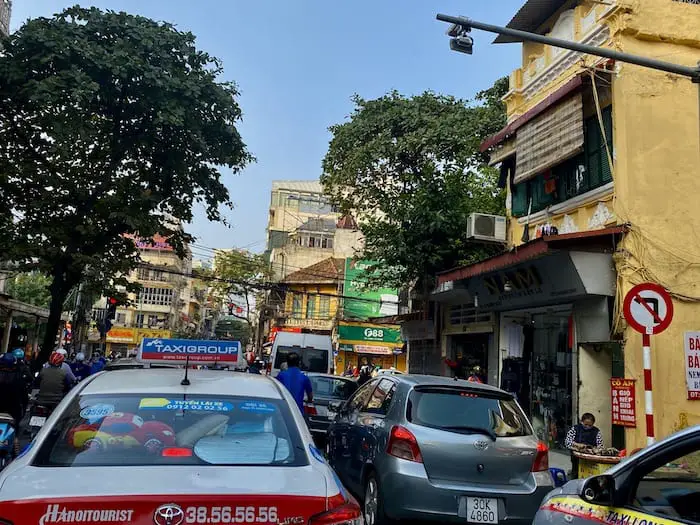
List of Old Quarter Streets and their English Meanings
Here is a list of most of the streets in the Old Quarters and their English meanings.
| Street Name | English Meaning | Street Name | English Meaning |
| Bat Dan | Wooden Bowls | Cha Ca | Roasted Fish |
| Bat Su | China Bowls | Chan Cam | String Instruments |
| Cho Gao | Rice Market | Gai Ngu | Fisherman |
| Hai Tuong | Sandals | Hang Bac | Silver |
| Hang Be | Rafts | Hang Bo | Baskets |
| Hang Bong | Cotton | Hang Buom | Sails |
| Hang But | Brushes | Hang Ca | Fish |
| Hang Can | Scales | Hang Chai | Bottles |
| Hang Chi | Thread | Hang Chieu | Mats |
| Hang Chinh | Jars | Hang Cot | Bamboo Latices |
| Hang Da | Leather | Hang Dao | Pick Blossoms/Silk |
| Hang Dau | Beans | Hang Dau | Oils |
| Hang Dieu | Pipes | Hang Dong | Copper |
| Hang Duong | Sugar | Hang Ga | Chicken |
| Hang Gai | Silk Fabric | Hang Giay | Paper |
| Hang Giay | Shoes | Hang Hanh | Onions |
| Hang Hom | Cases | Hang Huong | Incense |
| Hang Khay | Trays | Hang Khoai | Sweet Potatoes |
| Hang Luoc | Comb | Hang Ma | Ancestor worship items |
| Hang Manh | Bamboo Screens | Hang Muoi | Salt |
| Hang Ngang | A Crossroad | Hang Non | Hats |
| Hang Phen | Alum Earth Spice | Hang Quat | Fans |
| Hang Ruoi | Worms | Hang Than | Charcoal |
| Hang Thiec | Tin | Hang Thung | Barrel |
| Hang Tre | Bamboo | Hang Trong | Drums |
| Hang Vai | Cloth | Lo Ren | Blacksmiths |
| Lo Su | Coffins | Ma May | Buddha/Joss Sticks |
| Ngo Gach | Bricks | Thuoc Bac | Herbal Medicine |
| Hang Mam | Pickled Fish | Cau Go | Wooden Bridge |
When you look at this list of the major streets in the Old Quarter in Hanoi, you can see how many of them are named after the kind of products the street would have sold at one time.
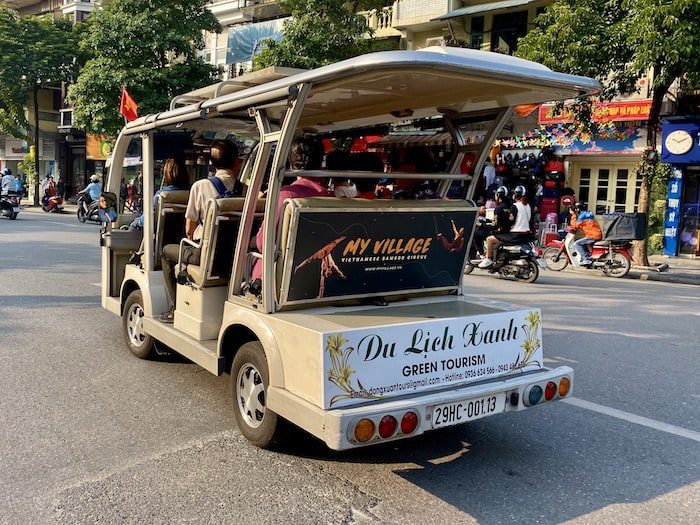
Riding the Electric Golf Cart to see the Old Quarters
One of the best ways to see the Old Quarters is to rent electric golf carts around the Old Quarters. It is a very safe way to see the streets, and you can cover many streets in an hour. This gives you a great overview of Hanoi and the Old Quarters.
One of the great things about golf carts is that they have two seats plus a seat next to the driver to fit seven people in one golf cart. Also, the carts go quite slowly, so they are very safe that even children can ride them.
The cost is about 360,000 dong for an hour or about 16 USD, and it is well worth the expense to see a lot of the Old Quarters that you may not be able to see just by walking.
You can rent the Golf cart on Hoan Kiem Lake’s north side, not too far from the Thang Long Water Puppet Show Theatre. You will see a booth on the lake; usually, the electric golf carts or buses sit outside the booth area. The name of the booth is Bo Ho Electric Bus Ticket Stall.
They have the prices listed on the booth and will give you a receipt. Tell them how many hours you want to rent the golf carts, and they will get you a cart and a driver.
Note: Prices can change, so check at the booth to know the current price
Besides going in the Old Quarters, the carts can also go around the Ho Chi Minh Mausoleum area and the other part of the downtown area. We have often used them to drop us off at certain locations, and the drivers would wait for us. So you can even rent the golf carts for a couple of hours and stop to see some sights or do some shopping.
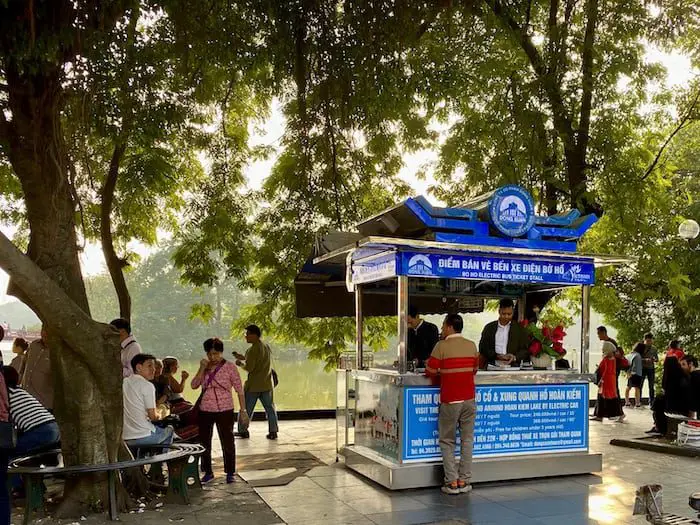
If you are traveling to Hanoi, seeing the Old Quarters is a place you must see. Not only does it have a rich history with some wonderful architecture, but it is at the heart of the city of Hanoi.
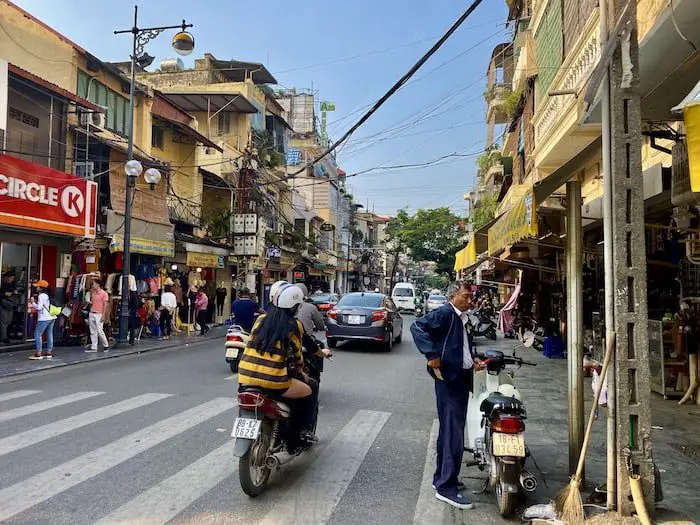
What about taking a cyclo ride around the Old Quarters of Hanoi?
Some may prefer to take a cyclo ride around the Old Quarters of Hanoi. A cyclo is a bicycle that has a place you can sit at the front of the bike. This is also a fun way to see some sites of the city, particularly the Old Quarter.
There are many cyclos around town; even some can be stationed near the Electric bus office where you will get your Golf Cart. Another location is near the Metropole Sofitel Hotel.
Normally you will need to bargain with the Cyclo drivers and be very specific about where you want to go and for how long.
Otherwise, I have found they will cut the time very short and then say, “Ok, we are done now.” So if you are not sure, you can also ask your hotel to help you sign up for a cyclo tour.

What about the Hop On Hop Off bus as a way to see Hanoi?
Hanoi’s great option for people to see Hanoi is the double-decker Hop On Hop Off buses that they have around town. These buses are open on the top, so you can see views of the city you may not see on a regular bus or in a taxi.
You can learn more about the Hop On Hop Off buses in Vietnam by clicking here.
At A Bus On A Dusty Road, we talk about travel, life, and ex-pat living. We are all about “Living Life As A Global Citizen.” We explore social, cultural, and economic issues and travel.
We would love to have you be part of our community. Sign up for our newsletter to keep up-to-date by clicking here. If you have any questions, you can contact me, Anita, by clicking here.
Listen to our Podcast called Dusty Roads. You can find it on all major podcast platforms. Try out listening to one of our podcasts by clicking here.
Subscribe to our A Bus On A Dusty Road YouTube Channel with great videos and information by clicking here.
Related Questions
What U. S Companies Profited During The Vietnam War?
During the Vietnam War, many U.S. companies profited from the Vietnam war. Some of these companies were heading toward bankruptcy, but their involvement in the Vietnam war helped make them profitable. For many others, they earned millions of dollars each year in profits from the war that helped ensure they continued to be successful or even thriving companies.
By clicking here, you can discover What U. S Companies Profited During The Vietnam War?
Could America Have Won The Vietnam War?
America could not have won the Vietnam war as it never won the hearts and minds of the Vietnamese people. The Americans even had difficulty controlling the Vietnamese people in Southern Vietnam, as many were disillusioned with the Southern Vietnamese government. Ho Chi Minh, the leader of North Vietnam, fully understood that another foreign power would not control the Vietnamese heart and soul.
By clicking here, you can discover Could America Have Won The Vietnam War?
What Was The Main Reason For US Involvement In Vietnam?
The main reason for the involvement of the United States in the Vietnam War was the belief in the Domino theory; the Domino theory was a principle used to describe the effects on the world if Vietnam fell to communism. The idea was that if Vietnam became communist, the rest of Asia, New Zealand, and Australia would eventually become communist. At the time, American leaders felt they were fighting for the survival of democracy throughout the world.
By clicking here, you can learn more by reading What Was The Main Reason For U.S. Involvement In Vietnam?


